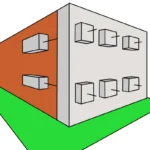What is the Internet of Things?
The Internet of Things, also known as “IoT,” is a process that enables the connection of everyday physical objects to the Internet. This includes common household items like light bulbs, medical devices in healthcare, smart clothing, personal accessories, and systems related to smart cities. The IoT concept refers to systems involving physical devices capable of receiving and transmitting data through wireless networks with minimal human intervention. This advancement is made possible by incorporating computing components into a wide range of objects.

IoT devices integrated into these physical objects generally fall into two main categories: they act as switches, meaning they issue instructions to an object, or they act as sensors, collecting data and sending it elsewhere. For example, a smart thermostat, an IoT-enabled device, receives information about the temperature in your home and allows you to adjust it, even if you’re not physically present.
Moreover, a web-connected smart lock responds to commands from a mobile device with internet access. These are just a few examples of how IoT is transforming our daily lives by connecting and enhancing the functionality of various devices and objects.

What is IoT in Civil Engineering?
The application of the Internet of Things (IoT) in civil engineering involves incorporating sensors and network-connected electronic devices into construction and infrastructure projects. These sensors can collect real-time data, facilitating more precise and agile decision-making in all aspects of a project.
Civil engineering projects can greatly benefit from the adoption of these IoT technologies and devices, significantly improving the automation and remote monitoring of numerous tasks. This allows operators to focus less on minor tasks that previously required constant attention. The data captured by these IoT devices can serve as a source of information to guide and support actions at various stages of the project.
Examples of this application include monitoring river flow to identify changes in flow over time and sending early flood alerts to nearby communities. Another example is tracking soil settlement processes or wind speed measurements in a specific location through IoT sensors. These devices enable continuous data collection, providing real-time insights into the conditions and progress of the work.

Civil engineering is entering a new era of innovation thanks to IoT, promising to improve our quality of life and the development of smarter and more efficient infrastructures.
Advantages of IoT in Civil Engineering
The Internet of Things (IoT) offers numerous advantages in the field of civil engineering, spanning from planning and design to construction and ongoing infrastructure management. Among the advantages are:
- Real-Time Monitoring: IoT sensors enable constant monitoring of the structural health of buildings, bridges, and other infrastructures. This provides real-time data on potential issues, facilitating early identification of potential problems and scheduling preventive maintenance.
- Energy Efficiency: Sensors in buildings can regulate systems such as lighting and air conditioning to reduce energy consumption and promote sustainability.
- Traffic Management: IoT devices in smart traffic lights, traffic surveillance cameras, and network-connected parking sensors contribute to reducing traffic congestion and improving traffic flow.
- Construction Safety: IoT devices, such as smart helmets and vests, can issue real-time alerts in case of detecting hazardous situations, increasing the safety of workers on construction sites.
- Improving Planning: Data collected through IoT sensors can be used to improve planning and decision-making in construction projects, reducing delays and unforeseen costs.
- Cost Savings: Early detection of problems and predictive maintenance reduce repair costs and increase the lifespan of infrastructures, resulting in long-term savings.
- Water Resources Management: In hydrology, IoT sensors can monitor, collect, and transmit constant information about water quality, soil moisture, precipitation intensity, evaporation, temperature, and water levels, enabling more efficient water resources management.
- Sustainability: IoT facilitates the implementation of more sustainable construction and management practices by optimizing resource usage and reducing environmental impact.
- Improving Quality of Life: Smart infrastructure management contributes to the comfort and safety of citizens, enhancing their quality of life in urban areas.
- Data for Decision-Making: The vast amount of data generated by IoT sensors provides valuable information for data-driven decision-making, enhancing efficiency and effectiveness in civil engineering.
The Future of IoT in Civil Engineering
The Internet of Things (IoT) is revolutionizing civil engineering by providing a platform for monitoring and optimizing infrastructures and construction projects. This technological advancement is improving the efficiency, safety, and sustainability of civil engineering projects worldwide, and its significance will only continue to grow as technology advances. The benefits range from early problem detection to cost savings and the promotion of sustainability, making this technology essential in the evolution of the civil engineering industry.

The Internet of Things continues to advance steadily, and its relevance in civil engineering will continue to expand. Significant advances are expected in fields such as artificial intelligence and automation, enabling even more effective and sustainable construction and management. Additionally, device interconnectivity and data analysis will promote more advanced and precise decision-making in the field of civil engineering.







Related
Sustainable Construction: Lean Construction Philosophy
Renewable Energy in Engineering.